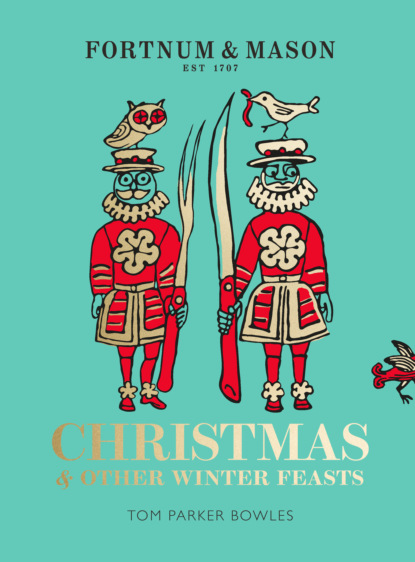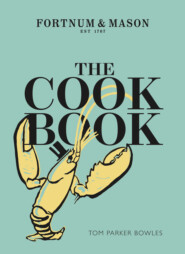По всем вопросам обращайтесь на: info@litportal.ru
(©) 2003-2024.
✖
Fortnum & Mason: Christmas & Other Winter Feasts
Настройки чтения
Размер шрифта
Высота строк
Поля
SHERRY
Forget the days, long past, where a glass of sherry meant a tot of your Granny’s oversweet stuff, poured from an old dusty bottle. Because at long last we’re starting to appreciate the endless glories of this wonderful Spanish fortified wine. A chilled glass of dry, delicate Fino, the perfect aperitif, which also stands up to the most robust of flavours, taking on garlic and chilli with equal aplomb. Oloroso VORS (very old and robust sherry) has been aged and is rich and nutty, while Manzanilla is less rich, with a saline whiff of the sea. For those looking for a bit more oomph, then Pedro Ximénez VOS (very old sherry) is the perfect end to dinner, deeply flavoured and intensely fruity, to be drunk with blue cheese, or with chocolate puddings, and equally wonderful poured over ice cream.
SLOE GIN
A stalwart of British winter, this deep purple libation manages to mix the sweet with the tart. A nip or two is an essential winter warmer, but it also makes a wonderful cocktail ingredient, used in Sloe Negronis and sloe toddies, too. Fortnum’s sell their version, but I always make my own. You’ll find the berries in late autumn: simply take a few handfuls (around 500g), freeze them overnight, then mix them with gin (good-quality please) and caster sugar (about 2 tablespoons) in a sterilised bottle. Leave for a couple of months in a dark place, and this regal concoction will be ready in time for Christmas.
SMOKED SALMON
The proper stuff, elegantly smoked (rather than choked with a bitter bonfire of fake oak flavouring), resolutely ungreasy, and elegantly, expertly sliced. Quality is everything: try to find a variety that uses fish farmed to the highest standards, as they do at Fortnum’s. The very best needs little more than a drizzle of lemon and a dusting of freshly ground black pepper, plus a great pile of thickly buttered brown bread. Or do as my mother does on Christmas night and make a huge pot of runny scrambled eggs, to sit atop a few slices of serious smoked salmon. Simple, and simply sensational.
STEM GINGER
Ginger was once one of the most important spices imported by Fortnum’s, and by the mid-nineteenth-century, they offered ‘preserved West Indian Ginger, clear and young, in original jars and bottles in various sizes,’ as well as East India Preserved Ginger, in small china jars. And a pickle called Chou Chou.
During the Great War, preserved ginger from Fortnum’s was a staple of parcels sent out to the Western front, and officers could share cubed glacé ginger, pickled Chinese stem ginger, Chyloong stem ginger, Piewoong Stem Ginger, Manloong Stem Ginger as well as that West India Ginger ‘beautifully clear and free from string,’ in heavy syrup. And Chow Chow (the spelling of this pickle had changed by 1914).
Ginger is one of those wonder spices, said to help everything from upset tummies to morning sickness. Which is why it’s so useful to have a jar of the stuff, preserved in syrup. You can add it to puddings, scatter it over ice cream, even eat it straight from the bottle. A store-cupboard essential.
STOLLEN CAKE
A classic German Christmas bread, you want to buy the big version, which should last you through the festive morass. It’s traditionally packed full of citrus peel, raisins and almonds, then sprinkled with a flurry of icing sugar. I rather like it toasted, and slathered with salty butter.
TURKISH DELIGHT
One glimpse of these lovely, heaven-scented lumps of pink, green and yellow delight, dusted liberally in icing sugar, and you see exactly why Edmund, in The Lion, the Witch and the Wardrobe, was so enamoured of the White Witch. The Dark Side has never seemed more delectable. Fortnum’s Turkish delight has been handmade by the same Istanbul family for over twenty years, meaning it’s a true taste of that great and glorious city. And there’s something about those smart wooden boxes that make this simple sweet seem all the more exotic.
VACHERIN
One of the great seasonal cow’s milk cheeses, Vacherin is made in both France and Switzerland, mainly in villages of the Jura region. Packaged in a spruce box, it should be left at room temperature until it becomes almost liquid. It has a rich, deep flavour and is also wonderful hot, simply heated in the oven with a few slivers of garlic, a couple of sprigs of thyme, and a splash of white wine. Serve with bread, potatoes and cornichons for the easiest fondue you’ll ever find.
WAXED CHEDDARS AND POTTED STILTONS
This is the sort of Christmas present that makes me very happy indeed. Proper Cheddar (as different from that crass mass-produced rubbish as truffle oil is from fresh white truffle), encased in a wax shell. The potted Stiltons look as good as they taste, filled with cheese made by the last family-owned producer in the country (and made with milk that by law must only come from Derbyshire, Nottingham or Leicestershire), this is a cheese that is rich, luscious and packed with blue-veined depth.
WHITE TRUFFLE
For me, the Alba truffle is the greatest of them all, and certainly the most expensive. And it’s not so much about the taste (the black truffle has more actual flavour), but rather that heady, sexy, slightly filthy scent that caresses the nostrils, and gets the taste buds priapic with anticipatory lust. Grate it over scrambled eggs, risotto, fresh pasta, or even, as they do in 45 Jermyn St., scatter it over a toasted cheese sandwich. Truffles will keep for about four days in a cool place, or longer, if you wrap them in kitchen paper and store them in a sealed glass jar in the fridge. Or, better still, store them with eggs, or risotto rice, where that divine scent will be absorbed. A walnut-sized truffle will cover about four portions of pasta. Fewer for the truly ardent truffle addicts. Like me.
WINES
Where do I start? The soft, silky beauty of a classic Margaux, or the light, strawberry-scented charms of a proper Provençal rosé. The complex, spiced depths of a serious Burgundy, compared to the rich, honeyed elegance of its white counterpart. There are Rieslings with the most luscious of finishes, flinty Chablis, vibrant Spanish Albariños, thrilling, berry-packed Australian reds, and fresh, slightly fizzy Vinhos Verdes. There’s a wine for every taste, a blend for every palate, some of them made for drinking alone, others that come alive when matched with food. Call the concierge or wine department for your own selection. You’ll all have your favourites, but sometimes, be bold, and try something new. Christmas Day is the one time of the year where it’s perfectly acceptable to have a glass of wine (or Champagne) for breakfast. Eat, drink and be merry. There’s always January for regrets.
YULE LOG
There’s a recipe for the rather lovely Black Forest Log (#litres_trial_promo) in the book. But whether you make your own, or simply buy one in, this divine log is as much symbolic as it is delectable. Back before the Victorians changed Christmas from wild bacchanalia to respectable family feast, a huge log, the largest that could fit in the fireplace, was lit on the first day of Christmas and expected to last twelve days. That tradition is long gone, but the edible Yule log remains.
ROAST PARTRIDGE, SALSIFY AND SAVOY CABBAGE WITH PORT AND FIG SAUCE (#ulink_ec897813-46f7-5a55-b4d4-221c7e9fa677)
Partridge has the most delicate, sweet flavour, a game bird to embrace, rather than fear. Throw in a rich, bacon-studded port reduction sauce, and you have a main course of true magnificence.
& lovely with a glass of fine claret
SERVES 4
· 4 partridges
· 80g butter
· 100g silverskin onions, peeled
· 4 garlic cloves, crushed
· a few sprigs of thyme
· 100g baby button mushrooms
· 80g smoked bacon lardons
· 250ml port
· 500ml beef stock
· 250ml brown chicken stock
· 2 fresh figs, cut into quarters
FOR THE SALSIFY AND SAVOY CABBAGE
· 4 salsify sticks
· a squeeze of lemon juice
· 1 head of Savoy cabbage
Remove the legs and breasts from the partridges (save the carcasses to make stock or soup, if you like). Heat 50g of the butter in a heavy-based saucepan. Season the legs, add them to the pan and sear until golden brown all over. Add the onions, garlic, thyme leaves, mushrooms and bacon lardons and cook until lightly coloured. Pour in the port and simmer until reduced by two-thirds. Now add the beef and chicken stock, bring to the boil and simmer gently for around 45 minutes, until the legs are tender. Remove the legs from the pan and set aside.
Next prepare the salsify and Savoy cabbage. Peel the salsify until you have removed all the brown. Bring a pan of salted water to the boil, add a good squeeze of lemon juice, then add the salsify and simmer for about 15 minutes, until tender. Drain well and cut into 3cm lengths. Blanch the Savoy cabbage in a separate pan of boiling salted water for 3–4 minutes, then drain, refresh in cold water and set aside.
Season the partridge breasts with salt and pepper. Heat the remaining butter in a large frying pan, add the partridge breasts, skin side down, and cook over a medium-high heat for about 4 minutes, until golden brown underneath. Turn and cook the other side for about 1 minute. Remove from the pan and leave to rest while you finish the dish.
Add the salsify to the frying pan and cook until golden brown all over. Add the Savoy cabbage and warm through gently. Season with salt and pepper.
Reheat the sauce, returning the partridge legs to it and adding the fig quarters. Check the seasoning.
To serve, put the cabbage and salsify in the centre of 4 plates. Arrange the partridge breasts and legs on top and generously spoon the fig sauce over.
POT-ROAST PHEASANT WITH PEARL BARLEY, BRAISED RED CABBAGE AND SWEDE SAUCE (#ulink_8a86bfba-d49b-5e06-9ec0-356ff31e6f32)






